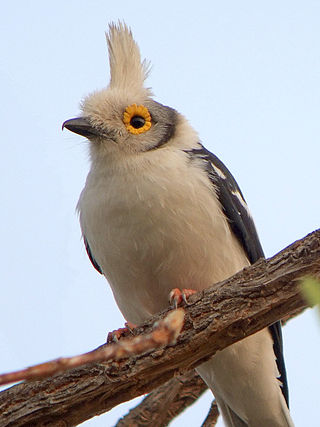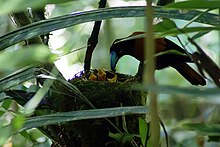The Old World warblers are a large group of birds formerly grouped together in the bird family Sylviidae. They are not closely related to the New World warblers. The family held over 400 species in over 70 genera, and were the source of much taxonomic confusion. Two families were split out initially, the cisticolas into Cisticolidae and the kinglets into Regulidae. In the past 20–30 years they have been the subject of much research and many species are now placed into other families, including the Acrocephalidae, Cettiidae, Phylloscopidae, and Megaluridae. In addition some species have been moved into existing families or have not yet had their placement fully resolved. Only a small number of warblers, in just two genera, are now retained in the family Sylviidae.

Helmetshrikes are the eight species of smallish to mid-sized songbirds in the genus Prionops. They were previously included with the true shrikes in the family Laniidae, later on split between several presumably closely related groups such as bushshrikes (Malaconotidae) and cuckooshrikes (Campephagidae), but are now considered sufficiently distinctive to be separated from that group into the family Vangidae.

The bushshrikes are smallish passerine birds. They were formerly classed with the true shrikes in the family Laniidae, but are now considered sufficiently distinctive to be separated from that group as the family Malaconotidae, a name that alludes to their fluffy back and rump feathers.

The bar-winged flycatcher-shrike is a small passerine bird usually placed in the Vangidae. It is found in the forests of tropical southern Asia from the Himalayas and hills of southern India to Indonesia. Mainly insectivorous it is found hunting in the mid-canopy of forests, often joining mixed-species foraging flocks. They perch upright and have a distinctive pattern of black and white, males being more shiny black than the females. In some populations the colour of the back is brownish while others have a dark wash on the underside.
A shrike is a passerine bird of the family Laniidae.

The Madagascar lowland forests or Madagascar humid forests are a tropical moist broadleaf forest ecoregion found on the eastern coast of the island of Madagascar, home to a plant and animal mix that is 80 to 90% endemic, with the forests of the eastern plain being a particularly important location of this endemism. They are included in the Global 200 list of outstanding ecoregions.

The helmet vanga is a distinctive-looking bird of the vanga family, Vangidae, and is classified in its own genus, Euryceros. It is mainly blue-black, with rufous wings and a huge arched blue bill. It is restricted to lowland and lower montane rainforests of northeastern Madagascar. Its diet is composed of invertebrates, predominantly insects. The species is threatened by habitat loss.

The black-and-white shrike-flycatcher, also known as the black-and-white flycatcher or vanga flycatcher, is a species of passerine bird found in Africa. It was placed with the wattle-eyes and batises in the family Platysteiridae but is now considered to be more closely related to the helmetshrikes and woodshrikes.

Calicalicus is a genus of bird in the family Vangidae. It contains two species, both of which are endemic to Madagascar:

The sickle-billed vanga is a species of bird in the vanga family Vangidae. It is monotypic within the genus Falculea. It is endemic to Madagascar. Its natural habitats are tropical dry forests and tropical dry shrubland.

The black-winged flycatcher-shrike is a species of bird in the flycatcher-shrike genus, Hemipus. It is usually placed in the Vangidae. It is found in the Malay Peninsula and the Greater Sunda Islands. Its natural habitats are lowland forests and sometimes swamps and mangroves. The International Union for Conservation of Nature (IUCN) has assessed it as being of least concern.

The red-billed helmetshrike or chestnut-bellied helmetshrike is a species of bird in the Vanga family, Vangidae, formerly usually included in the Malaconotidae.

The woodshrikes are a genus, Tephrodornis, of birds in the family Vangidae.

Newtonia is a genus of passerine birds containing four to five species. They were formerly classified in the Old World warbler family Sylviidae or Old World flycatcher family Muscicapidae but have recently been shown to belong to the vanga family Vangidae. They are endemic to Madagascar where they occur in forest or scrubland. They forage in pairs for insects, often joining mixed-species feeding flocks.

Zahamena National Park is a national park of Madagascar. Established in 1997, it covers an area of 423 square kilometres (163.32 sq mi) out of a total protected area of 643 square kilometres (248.26 sq mi). It is part of a UNESCO World Heritage Site, Rainforests of the Atsinanana, inscribed in 2007 and consisting of 13 specific areas located within eight national parks in the eastern part of Madagascar. In 2001, Bird Life International assessed avifauna of 112 species of which 67 species are exclusively endemic to Madagascar.

The rufous-bellied helmetshrike or Gabon helmetshrike is a passerine bird belonging to the Vanga family, Vangidae. It inhabits tropical forest in Central Africa. It is sometimes included within the chestnut-bellied helmetshrike of West Africa.

Malaconotoidea is a superfamily of passerine birds. They contain a vast diversity of omnivorous and carnivorous songbirds widespread in Africa and Australia, many of which superficially resemble shrikes. It was defined and named by Cacraft and colleagues in 2004 and contains the bushshrikes (Malaconotidae), helmetshrikes (Prionopidae), ioras (Aegithinidae), vangas (Vangidae) and the Australian butcherbirds, magpies, currawongs and woodswallows (Artamidae). Molecular analysis in 2006 added the Bornean bristlehead to the group, though its position in the Malconotoidea is unclear. It was initially thought related to the butcherbirds and woodswallows but now is thought to be an early offshoot.


















